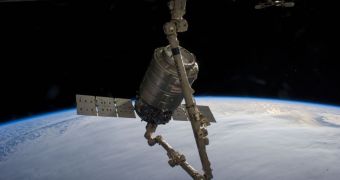Members of the Expedition 38 crew aboard the International Space Station (ISS) are currently unloading the Cygnus spacecraft that arrived at the space lab on Sunday, January 12. One of the most important payloads on the resupply capsule is a constellation of 28 nanosatellites.
The Orbital-1 cargo resupply mission was conducted using an Antares delivery system and a Cygnus capsule, both of which were designed and built by Dulles, Virginia-based Orbital Sciences Corporation, under a $1.9 billion (€1.4 billion) contract with NASA.
Cygnus delivers a total of 1,261 kilograms (2,780 pounds) of cargo to the International Space Station, including a large number of science experiments, spare parts, various hardware, and crew provisions such as air, water, fuel for the station's maneuvering thrusters and personal items for the six astronauts.
Its flight to resupply the station, called Orb-1, is the first in a series of 8 similar missions that OSC has to conduct over the next few years. All of these flights are stipulated in the Commercial Resupply Services (CRS) contract the company signed with the American space agency.
In addition to the cargo it delivered to the station, the Cygnus was also loaded with a constellation of 28 small satellites, known as Flock-1. These tiny spacecraft were part of the NanoRacks-Planet Labs-Dove payload on the capsule, and were developed by Planet Labs.
Despite their diminutive size, these satellites will be used for Earth-imaging studies. Their sensors have a resolution of 3 to 5 meters (10 to 16 feet) per pixel, which may not seem like a lot at first. The main benefit of this satellite swarm is that what its members lack in individual capabilities they make up for with great numbers.
In addition to monitoring changes on the surface of the planet, the constellation will also be able to provide critical data for humanitarian and environmental applications, experts from Planet Labs say. Other potential uses range from deforestation monitoring to ice cap surveillance.
The Flock-1 constellation was joined by the ArduSat-2 electronics/hardware experiment and by the SkyCube satellite inside the Cygnus spacecraft. ArduSat-2 is a project remarkable through the fact that it was sponsored via crowdsourcing.
With this successful delivery, OSC has demonstrated that its rocket/capsule combo is viable, and represents a worthy investment for the dollars NASA put in. The Antares rocket launched Cygnus into space on January 9, from the NASA Wallops Flight Facility, on Wallops Island, Virginia.

 14 DAY TRIAL //
14 DAY TRIAL //